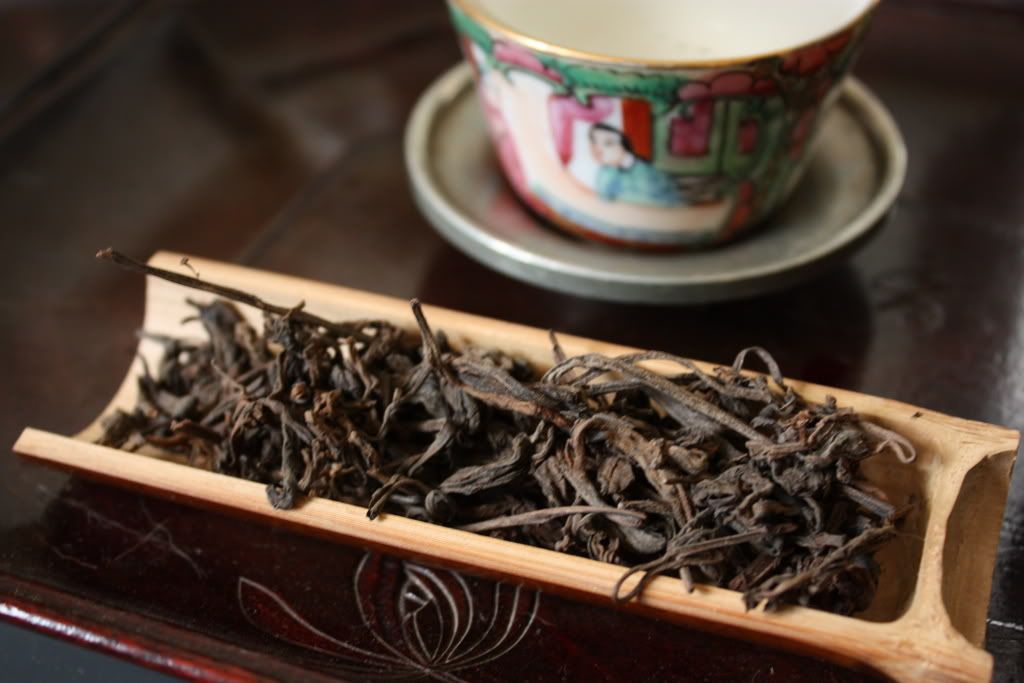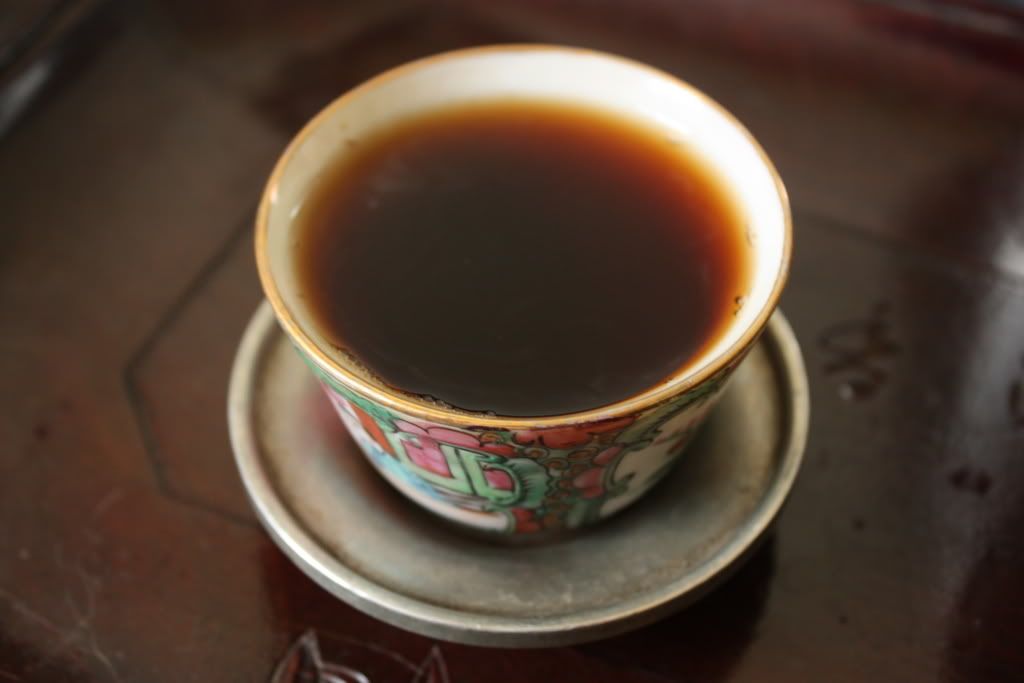Lew of the ever expanding Babelcarp kindly gave me this sample when I was in New York

The tea is from Taipei — a store that I actually visited once or twice, and then through a friend of his came into his possession. When I first saw it and smelled and looked, I told Lew that I think it’s a “border tea”, which generally means non-Yunnan tea made into some sort of puerh. On the back of the bag it says Yiwu Maocha, but every maocha out there is Yiwu….
The reason I said it’s border tea is because it smelled like it, and it also looked like it — long, wiry, thin stems with that twisted look. Yunnan tea generally looks a little fatter and shorter. I have a cake of this stuff, and also some various assortment of loose tea that are almost certainly border tea — most likely of Vietnamese origin. They also have this distinctive smell — it’s best described as somewhat spicy, and after trying a number of these things, quite common.
They also tend to brew dark

And they look dark when wet

The taste is usually of the same spicy note you’ll smell, and tend to be a little thin in terms of body. Mind you, they’re hardly bad — I’d drink this anytime. They’re just not Yunnan in origin, and is often passed off as higher grade stuff, which it decidedly isn’t. The most famous border tea that is easily obtainable is probably the 1980s or 1990s Hongtaichang, which you might see quite often. They have a squarish neifei with about four columns of words and usually no wrapper. I’ve seen them sold at various places, including M3T in Paris and shops in Taiwan, as genuine Yunnan puerh with the price to boot. If you find them in places that sell them for what they are, they are fairly cheap (under $50 a cake). For a 1980s or 1990s tea, it’s not bad…
Thank you, Lew, for the nice sample. I tend to like these mellow, easy to drink things. It’s less stressful to make than younger or harsher teas.

 RSS - Posts
RSS - Posts
5 responses so far ↓
iwii // July 15, 2008 at 8:09 am |
Interesting! That’s definitely looking like border tea leaves, but I wasn’t expecting these had a distinctive smell.
The ones I met were, unfortunately, quite nastily stored and so were not really smelling anything more than wet storage. What’s the difference with the Yunnan leaves. Does it smell a bit more acidic?
MarshalN // July 16, 2008 at 12:19 am |
I think they do smell/taste similar to one another… and look the part too.
The smell is best described as…. spicy. I don’t know what else to say other than that.
lewperin // July 16, 2008 at 5:08 pm |
I don’t have the experience to know whether maocha is border tea, because the only 2 teas I’ve had that are advertised as border tea are cakes. But as to aroma and taste, the Vietnam border cakes I’ve known both have a very cutting kind of herbal bitterness that makes me think of Chinese apothecary shops. (I get that herbal bitterness from a number of supposedly Xishuangbanna or Lincang shu teas also, but not nearly as strongly.) I don’t get it from this tea, though I do get a kind of peppery quality (which I also remember from the even-pepperier Red Label.)
Anyway, what I got from this maocha in a recent session follows. All timings are in seconds, not because I’m that accurate but because I find it easier to write it that way. There was a rinse. In all the steeps of two minutes or longer, I tried to get the brewing temperature as high as possible by either starting one steep as soon as the previous one was poured off or by rinsing with boiling water before the steep (or both!) The steep times were 5,5,5,5,5,30,60,120,180,300,450,600,900,1200:
1: Brewed leaf aroma pond, forest floor, wood. Cup aroma a little peppery, woody.
Taste woody, a little peppery, a bit sweet, nice, long-lasting, smooth
houyun. 2: Taste sweeter now. 3: Aroma has a deep, sweet quality
like ’70s Guangyungong; taste like 2. 4: About the same, but there’s
a slightly powdery mouth feel (not astringency.) 5: Same. 6: Flavor
more penetrating with longer steep time, quite sweet, still the
powdery mouth feel; peppery quality gone. 7: Same. 8: Not as sweet,
but a pleasant woodiness comes to the fore; powdery mouthfeel gone.
9: Still woody, but sweetness is strong again – could this be the
start of tian shui? Houyun has been consistent through this steep.
10: Starting to get a cereal tianshui quality, though there’s still
the woody note and the broth’s still fairly thick. 11: Still has that
GYG-like aroma; taste about the same as 10. 12: Still woody, still
sweet, maybe less characterful though. 13: Nice, cereal tianshui with
just enough fruit to make it interesting. 14: Still has a hint of
GYG, still not really thin; could go further.
MarshalN // July 17, 2008 at 12:06 am |
Lew: I think your notes point to an interesting thing — that it tastes like 70s GYG. There’s obviously no need for me to tell you what 70s GYG is made of — so I think that, in and of itself, tells you something about this maocha, no?
My experience with border tea has actually not involved bitterness at all — at least not much. I find Vietnamese teas to be generally sweet.
lewperin // July 18, 2008 at 2:40 pm |
I think your notes point to an interesting thing — that it tastes like 70s GYG. There’s obviously no need for me to tell you what 70s GYG is made of — so I think that, in and of itself, tells you something about this maocha, no?
I hope I’m not splitting hairs – or leaves – here, but it’s my understanding that GYG is part “real” Pu’er and part Guangdong leaf. And “border tea” normally refers to the border between southeastern Yunnan and Vietnam, right? For example, you wouldn’t call Lu’an or Liubao border tea, would you?
By the way, I’m not at all defending the package’s claim that this stuff is from Yiwu. As someone who’s been photographed on Yiwu Street in Jinghong, I take that responsibility seriously!